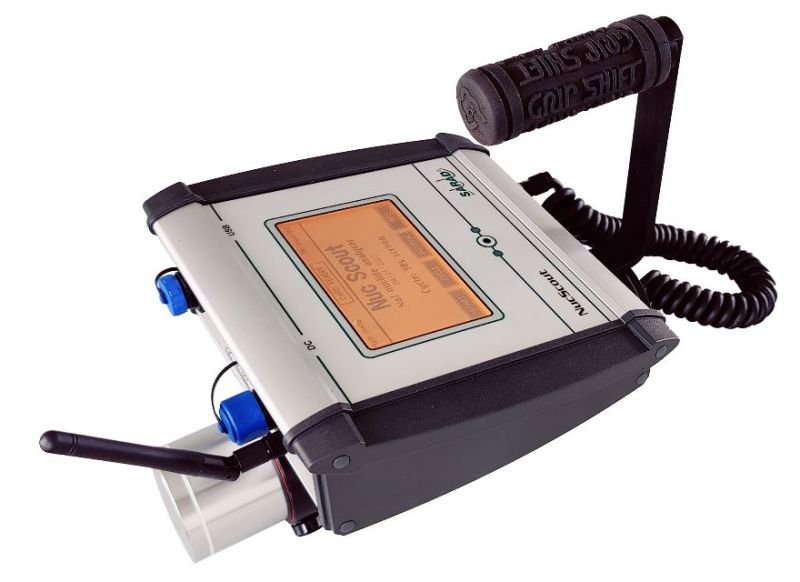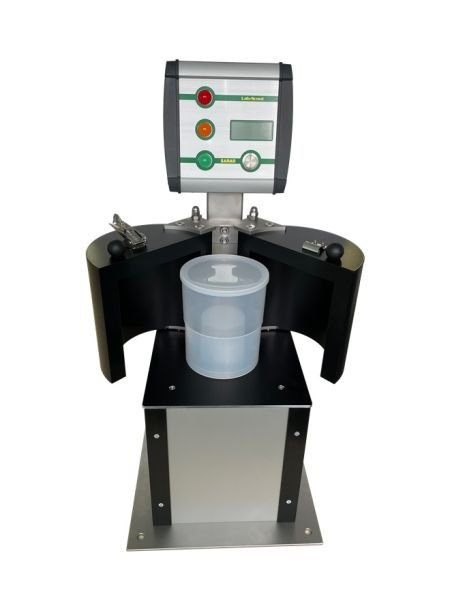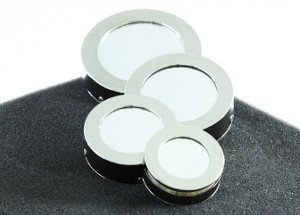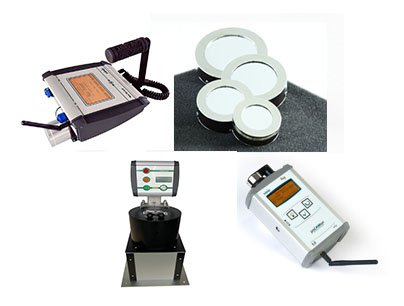Radioactive contamination, source search
Nuc Scout : Dose rate meter with nuclide identification

The Nuc Scout can measure the ambient dose rate and activities of up to 28 user-defined individual nuclides over long periods of time. The measurement is performed cyclically at a configurable time interval, for which a spectrum is stored on the internal memory card.
The device features an integrated GPS receiver, which allows for the spatial assignment of measurement data. Individual measurements are also possible. It is very easy to calibrate by the user, allowing the detector efficiency to be determined and applied for any measurement geometry. An internal wireless network interface is available, which can transmit current measurement data to a base station over distances of several hundred meters.
Typical areas of application are:
- the detection of radioactive sources,
- the assessment of large-scale contamination based on geoinformation systems (GIS),
- Monitoring measurements of food and building materials,
- nuclear medicine.
The handy and robust 2 × 2-inch NaI(Tl) detector is permanently attached to the handle, onto which the electronics unit can be attached using a bayonet lock. This allows the detector to be positioned at any angle relative to the source.
An optional measuring stage for Marinelli cups is available. Thanks to the large detector volume, even weak sources can be detected.
The large touchscreen allows comfortable operation and the display of spectra and measurement data even in bright sunlight.
In addition to the powerful peak shape verification algorithm for nuclide identification, the proven trapezoid method is available for calculating the activity of individual nuclides (e.g. for calibration purposes).
The scope of delivery includes a comprehensive software package for acquiring, displaying, and exporting measurement data. A number of tools enable quick, easy, and intuitive detector calibration (energy, peak width, efficiency) as well as complete library management. The software allows for complete remote operation of the device via USB or a wireless network.
The Nuc Scout is delivered with IP65 protection and can optionally be equipped with a 3 × 3-inch NaI(Tl) detector.
poCAMon : Portable Continuous Air MonitorLab Scout : Radiation meter with integrated scale

The Lab Scout is an extremely easy-to-use instrument for determining natural and artificial radionuclides in material samples. Routine operation requires neither a computer nor specialized personnel skills. Of course, the device can also be used as a flexible and powerful laboratory instrument.
The highly sensitive, temperature-compensated 2 × 2-inch NaI detector with magnetic shielding offers excellent spectroscopic resolution and a wide measurement range from 25 keV to 3 MeV. A two-centimeter thick 360° lead shield serves to attenuate background radiation and thus lower the detection limits.
The included operating software for Windows PCs enables intuitive calibration with just a few mouse clicks using acquired reference sample spectra. In addition to detector-specific energy and peak width calibration, an efficiency calibration wizard is available for any sample geometry. Calibration curves are included for various standard measurements (e.g., Marinelli beakers), which can be loaded into the instrument as needed.
From an editable nuclide library, nuclide lists with up to 16 emission lines can be compiled, tailored to the specific measurement task. The acquired spectrum is analyzed for these emission lines using the PSV algorithm. Once a line has been identified and verified, the weight-specific activity of the nuclide in the sample is calculated using the efficiency calibration and the built-in balance.
Ion-implanted Si detectors for alpha spectroscopy

SARAD has been manufacturing ion-implanted surface detectors for spectroscopic measurements since 1994. These detectors have proven themselves thousands of times over as standard detectors or in our measurement instruments. Key features include their robustness, low background signal, and excellent spectroscopic resolution even at low bias voltages.
Bias voltages as low as 10 volts enable the complete absorption of alpha radiation up to an emission energy of 10 MeV. The space charge zone depth of the BS types, specially developed for beta detection, is more than 500 µm. All detector types can be used both under ambient conditions and in a vacuum chamber. The entrance window is coated with a 50 nm (V-type) or 500 nm (E-type) thick aluminum passivation layer. The E-types are therefore particularly suitable for applications requiring work under daylight conditions.
The detectors are supplied with an industry-standard Microdot™ connector, ensuring compatibility with other manufacturers. Alternatively, the detectors can be ordered with BNC or SMA connectors.
